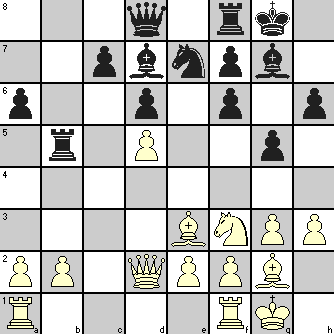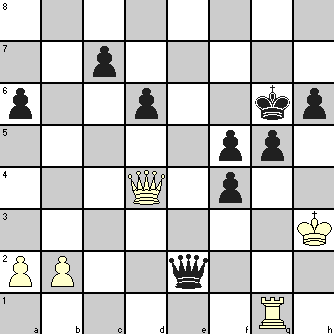With reference to our article on Chess Sacrifice as Chess Tactics, we are now taking up the use of sacrifice as an indirect way to win through the creation of passed pawns.
You know that a passed pawn can be promoted to a Queen, assuming that is what you will want most of the time. And you know the power a Queen commands in a chess game. So if you sacrifice even your Queen against, say, a Bishop to get a passed pawn that can become a Queen, you are in effect getting a Bishop for a pawn! You may like to go through Chess Tactics in Middle Game: Give up Queens to get Passed Pawns to see Queen sacrifices galore!
It is therefore no wonder that many chess tactics are built upon this potential value of pawns. Chess games abound in examples where a lot of tactical moves and exchanges have been made solely to get a passed pawn! Pawns are given away not casually but only as a part of a deeper plan in mind to gain compensation through better attack, better control of space, support for your pieces and such other tactical considerations. The chess tactics to create passed pawns gain particular importance as you enter the endgame. The value of passed pawn increases manifold if there are more than one such pawn linked together, which can sometimes refute even the power of the opponent’s Queen. A player who does not appreciate this value of pawns will come to regret sooner or later.
However, you may feel that in trying to show the use of sacrifice as a chess tactics to create passed pawns, we have gone a little overboard in choosing our example! Even though White had a Queen and a Rook against Black’s Queen after 32 moves, he gave up as he must have felt it a futile effort to stop Black’s passed pawns, as many as five of them!
You will say that in terms of the notional value, it was not a sacrifice by Black but a fair exchange (or rather unfair exchange considering value multiplier for linked pawns) in his favor! If you think so, please remember that when Black started the series of sacrifices giving up his Rook pair in exchange of the Bishop pair, he was only two pawns to the good at the end of 23 moves, and none of those were passed pawns.
I selected this game as remarkable from this consideration, particularly when you take into account the quality of the opponent faced by Shirov playing as Black. He won it in a game played at Manila in 1990 against Joel Lautier, who was then the highest-rated GM in France and held by some people as a future World Champion.
Joel Lautier (b.1973) became a World Champion in under-14 category in 1986 and a World Junior Chess Champion (under-20) in 1988. He won the French championship in 2004.
Alexey Shirov (b.1972) was the World Champion in under-16 category in 1988 and became a GM in 1990. In 1994, he became a citizen of Spain. He has always been a crowd favorite because of his aggressive and imaginative style in the line of Mikhail Tal, not surprisingly as he was born in Riga and studied under ‘the Magician from Riga’. You will find him listed in our article Chess tactics: Which masters to study? as one of the masters to study for learning combination play and chess tactics.
The diagram shows the position when it all started after 15 moves had been completed.

| 16. | Nd4 | Rxd5 | Black’s first sacrifice taking out first White pawn. | |
| 17. | Bxd5 | Nxd5 | ||
| 18. | Nf5 | Bxf5 | ||
| 19. | Qxd5 | Bxh3 | The second White pawn to go. | |
| 20. | Rfd1 | Re8 | ||
| 21. | Rac1 | f5 | ||
| 22. | Rd2 | Rxe3 | Black’s second sacrifice. | |
| 23. | fxe3 | Qe7 | ||
| 24. | Kf2 | Be5 | ||
| 25. | Rh1 | Bxg3+ | White’s third pawn falls. For Black, the Bishop is a sham sacrifice as he was planning to capture a Rook. White was forced to accept the offer as 26. Kg1 Qxe3# or 26. Kf3 g4+ again forces the issue. |
|
| 26. | Kxg3 | Qxe3+ | White loses the fourth pawn | |
| 27. | Qf3 | Qxd2 | Loss of Rook was inevitable for 27. Kh2 Qf2+ 28. Kxh3 g4# | |
| 28. | Qa8+ | Kg7 | ||
| 29. | Kxh3 | Qxe2 | White’s fifth and the last K-side pawn vanishes! | |
| 30. | Qd5 | Kg6 | 30. … Qf2 should have won straightaway because of the threat 31. … g4#. If 31. Qg2 then 31. … Qh4#. In any case, the end was near! | |
| 31. | Qd4 | f4 | ||
| 32. | Rg1 | f5 | White resigned as nothing much could be done against such a pawn phalanx! Black was threatening 33. … g4+ 34. Kh4 Qh2# or if 33. Rh1 then 33. … Qf3+ 34. Kh2 Qg3# |
The interesting position after 32 moves when White gave up the struggle. Anyone for more passed pawns!?

Watch the Actual Game
httpv://www.youtube.com/watch?v=8wR-1Nxo-_0


3 Comments
Sometimes fake moves could make you win the game. According to Siegbert Tarrasch “Up to this point White has been following well-known analysis. But
now he makes a fatal error: he begins to use his own head”
This quote proves the usefulness of fake moves.
Nice quote and I like the wry humor!
But he probably did not realize that everybody is doomed to use his head. He either uses it to explore territory outside charted ones and lose his way, or try to store information relating to all the charted areas but unable to find the way in the labyrinth of variations!
Its really true that to get something big you must have to sacrifice some little.
Trackbacks/Pingbacks